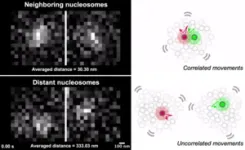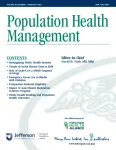The human genome DNA has a remarkable capacity for compaction. When 46 sets of human chromosomes are stretched end to end, they collectively reach two meters in length but are somehow arranged in a nucleus with only about ten micrometers in diameter. To fit inside the nucleus, the strands of DNA are wrapped around groups of histone proteins, like a thread around a spool, to form structures known as nucleosomes. Nucleosomes can be folded with other proteins into more compact structures, called chromatin. Despite great advances in technology over the last century, the physical characteristics of actively expressed chromatin, or euchromatin, remain a mystery.
Recent research unveils that euchromatin is condensed, rather than decondensed and open, in living human cells and behaves like a liquid at the nucleosome level. At the chromosome level (or the micrometer scale), chromatin is stable and behaves like a solid, which may limit DNA damage by reducing entanglements of long DNA.
A team led by Professor Kazuhiro Maeshima of SOKENDAI and the National Institute of Genetics (Research Organization of Information and Systems) recently investigated euchromatin, to determine the physical characteristics of euchromatin, whether it is open or condensed and liquid- or solid-like. Euchromatin is often transcribed for gene expression in living human cells.The team used a combination of genomics, single-nucleosome imaging, and computational modeling to assess euchromatin in cells. Prior to this study, euchromatin was thought to have an open, or less condensed, conformation to allow the large proteins associated with gene transcription access to genomic DNA. Instead, the researchers discovered that euchromatin in living cells formed condensed domains that behaved like a viscous fluid at the level of individual nucleosomes and behaved like a solid at the chromosome level.
The team published their results on April 5 in Science Advances.
Doi: 10.1126/sciadv.adf1488
http://www.science.org/doi/10.1126/sciadv.adf1488
“We demonstrated that euchromatin in living human cells does not necessarily exist as open structures, but instead it essentially forms condensed domains,” said Maeshima.
The research team introduced fluorescently-labeled nucleotides into living cells and visualized nucleosomes in close vicinity to one another using super-resolution microscopes(see the video). “Nucleosomes, the basic units of chromatin, fluctuated and behaved like a liquid inside the condensed euchromatin domains,” said Maeshima. What the scientists observed challenged conventional thinking regarding the conformation of euchromatin. “The dynamic, liquid-like behavior of nucleosomes we observed allows active transcription even in condensed euchromatin,” said Maeshima. "The condensed domains can protect DNA from radiation damage due to reduced physical access to DNA and decreased reactive chemical production," one of the coauthors, Shiori Iida added.
In contrast to the nucleosome level, euchromatin behaved like a solid at the chromosomal level, which the researchers propose could avoid excess entanglements of long genome DNA and keep it intact without breaks.
The new model of condensed euchromatin structure proposed by the researchers provides a mechanism to decrease the “stickiness” of chromatin through the acetylation of, or addition of an acetyl group to, histones. This opens up chromatin structure in order to accommodate large transcription or replication complexes and to regulate the expression of genes. The researchers also point out that chromatin condensation and organization may play an important role in cell differentiation, or specialization, as the chromatin domains of undifferentiated embryonic mouse stem cells, for example, are more fluid and less defined.
“Our ultimate goal is to reveal how genome information is searched and read out in living cells,” said Maeshima. The current study will help scientists better understand gene regulation, DNA replication and repair in living cells. The novel imaging techniques the research team developed will also provide a means for researchers to investigate other nanometer-scale molecules and their dynamics within the cell.
Other contributors include Tadasu Nozaki, Satoru Ide, Koichi Higashi, Sachiko Tamura, Masa A. Shimazoe, Ken Kurokawa, Shiori Iida from the National Institute of Genetics in Mishima, Japan (S. Ide, K. Higashi, M.A. Shimazoe, K. Kurokawa and S. Iida also belong to SOKENDAI in Mishima); Soya Shinkai, Shuichi Onami, and Yasushi Okada from the Center for Biosystems Dynamics Research (BDR) at RIKEN in Kobe, Japan; Masaki Nakagawa from the Fukuoka Institute of Technology in Fukuoka, Japan; Yutaka Suzuki from the University Tokyo in Kashiwa, Japan; Masaki Sasai from the Kyoto University.
This research was supported by JSPS grants 21H02453, 22H05606, 21H02535, 20H05550, 20H05936, JST CREST grant JPMJCR15G2, JST SPRING grant JPMJSP2104, and the Uehara Memorial Foundation.
Suggested EurekAlert! Summary:
The human genome has a remarkable capacity for compaction. When 46 sets of human chromosomes are stretched end to end, they collectively reach two meters in length but are somehow arranged in a nucleus with only ten micrometers in diameter. The physical characteristics of actively expressed chromatin, or euchromatin, remain a mystery. Recent research suggests that euchromatin mainly contributes to gene regulation in a condensed state, rather than decondensed and open, where it behaves like a liquid at the nucleosome level in living human cells. At the chromosomal level (or the micrometers scale), chromatin is stable and behaves like a solid, which may limit DNA damage by reducing entanglements of long DNA.
###
About National Institute of Genetics (NIG)
National Institute of Genetics (NIG) was established to carry out broad and comprehensive research in genetics. NIG contributes to the development of academic research as one of the inter-university research institutes constituting the Research Organization of Information and Systems (ROIS).
About the Research Organization of Information and Systems (ROIS)
ROIS is a parent organization of four national institutes (National Institute of Polar Research, National Institute of Informatics, the Institute of Statistical Mathematics and National Institute of Genetics) and the Joint Support-Center for Data Science Research. It is ROIS's mission to promote integrated, cutting-edge research that goes beyond the barriers of these institutions, in addition to facilitating their research activities, as members of inter-university research institutes.
END







